Auditing for Fraud Detection and Risk Management
VerifiedAdded on 2020/03/02
|15
|2779
|41
AI Summary
This assignment delves into the detection of fraud and unethical activities within a company by examining its financial statements. It focuses on identifying accounting irregularities, such as manipulating profits and revenue to mislead stakeholders, and analyzes the inherent risks associated with these practices. The assignment emphasizes the role of auditors in assessing financial information, understanding risk factors related to key business processes, and applying auditing techniques to uncover potential fraud.
Contribute Materials
Your contribution can guide someone’s learning journey. Share your
documents today.
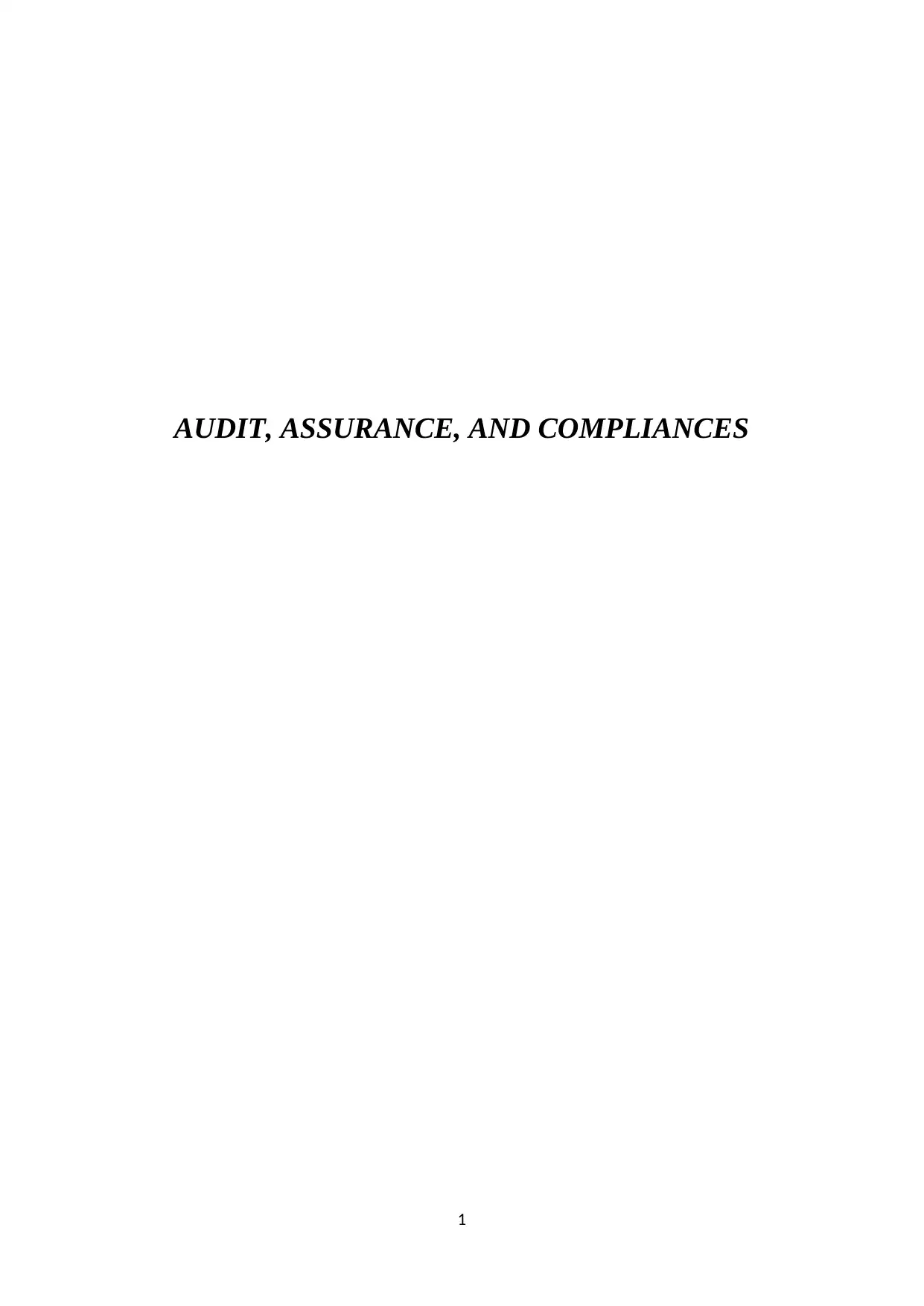
AUDIT, ASSURANCE, AND COMPLIANCES
1
1
Secure Best Marks with AI Grader
Need help grading? Try our AI Grader for instant feedback on your assignments.
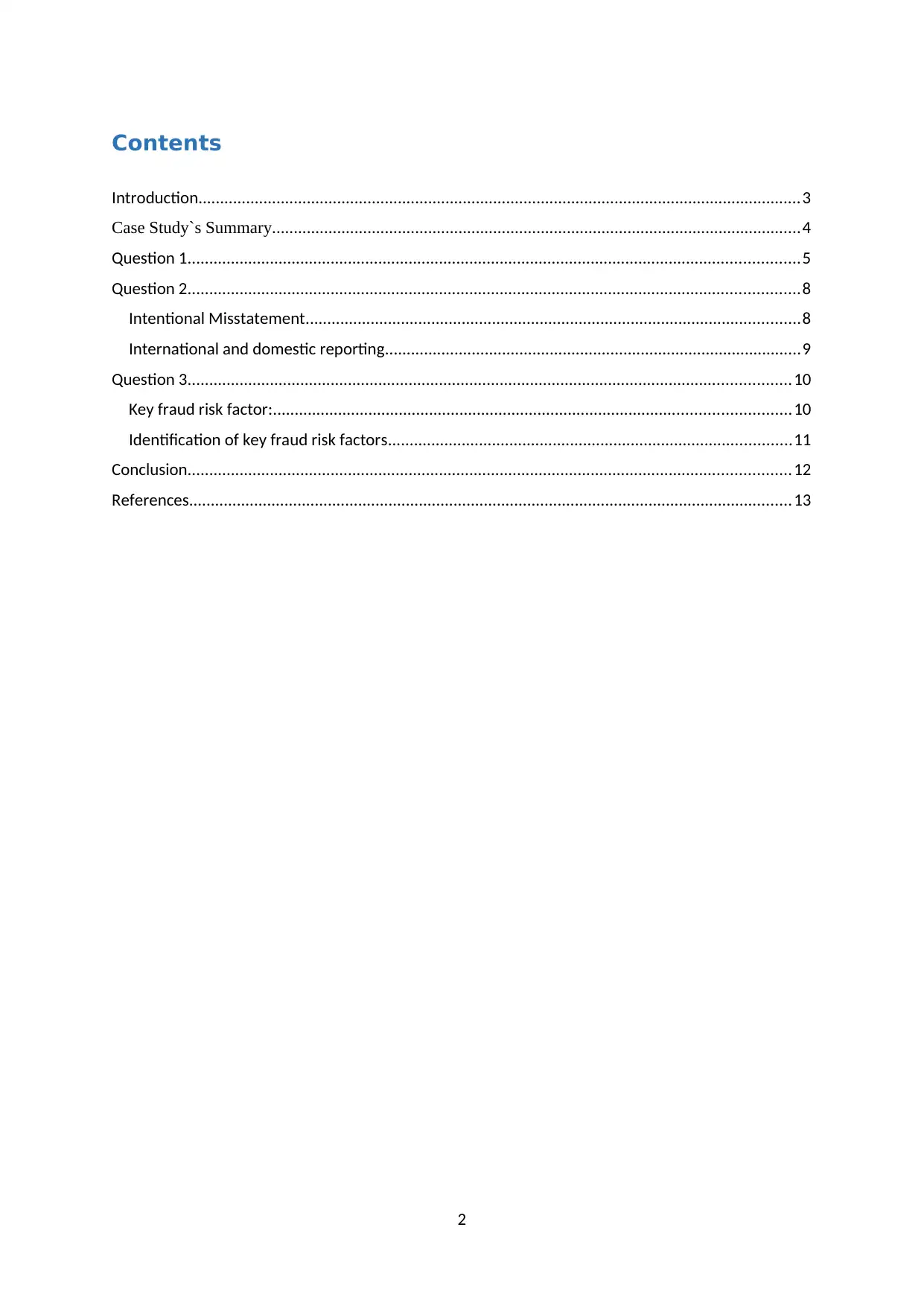
Contents
Introduction...........................................................................................................................................3
Case Study`s Summary..........................................................................................................................4
Question 1.............................................................................................................................................5
Question 2.............................................................................................................................................8
Intentional Misstatement..................................................................................................................8
International and domestic reporting................................................................................................9
Question 3...........................................................................................................................................10
Key fraud risk factor:.......................................................................................................................10
Identification of key fraud risk factors.............................................................................................11
Conclusion...........................................................................................................................................12
References...........................................................................................................................................13
2
Introduction...........................................................................................................................................3
Case Study`s Summary..........................................................................................................................4
Question 1.............................................................................................................................................5
Question 2.............................................................................................................................................8
Intentional Misstatement..................................................................................................................8
International and domestic reporting................................................................................................9
Question 3...........................................................................................................................................10
Key fraud risk factor:.......................................................................................................................10
Identification of key fraud risk factors.............................................................................................11
Conclusion...........................................................................................................................................12
References...........................................................................................................................................13
2
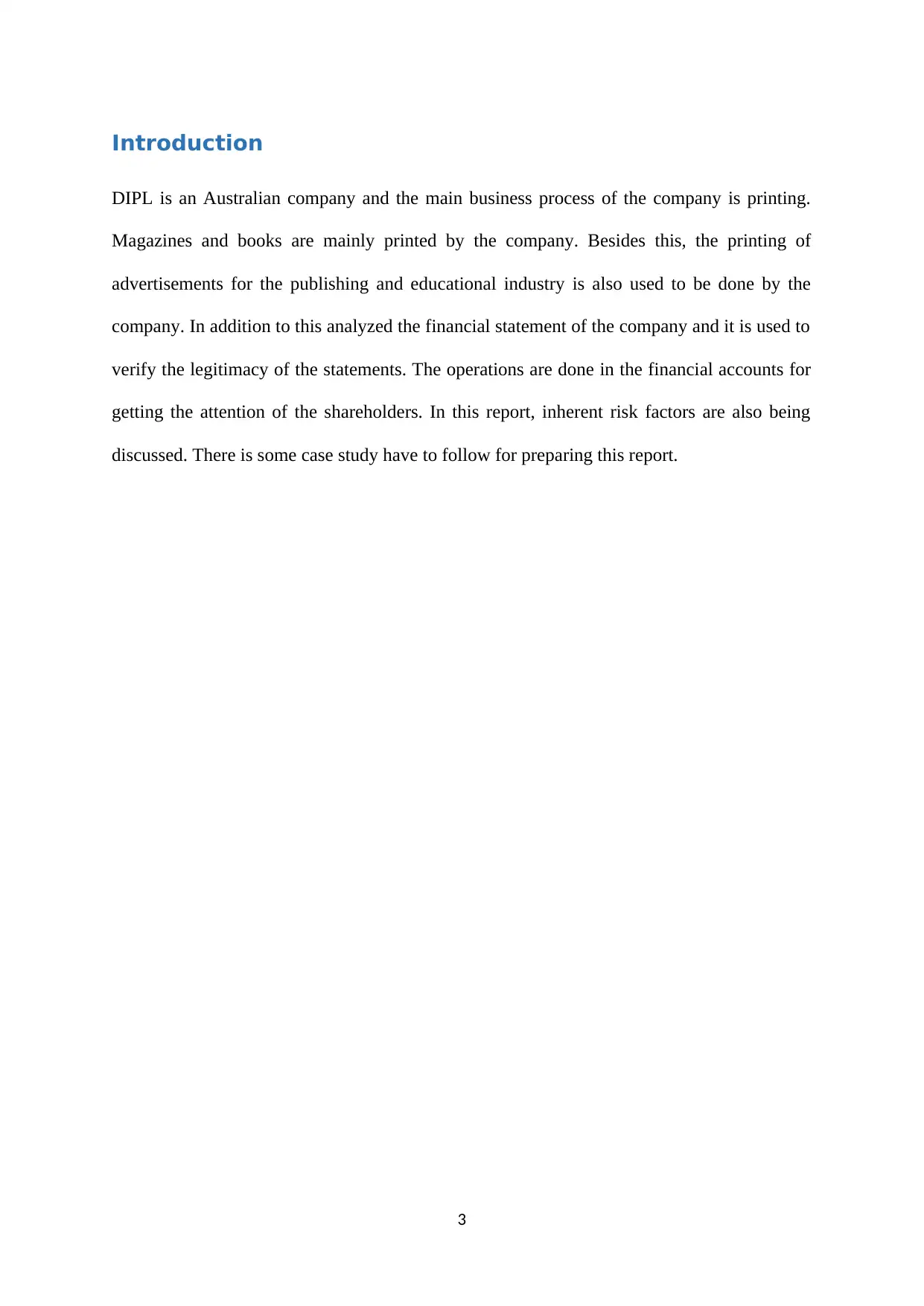
Introduction
DIPL is an Australian company and the main business process of the company is printing.
Magazines and books are mainly printed by the company. Besides this, the printing of
advertisements for the publishing and educational industry is also used to be done by the
company. In addition to this analyzed the financial statement of the company and it is used to
verify the legitimacy of the statements. The operations are done in the financial accounts for
getting the attention of the shareholders. In this report, inherent risk factors are also being
discussed. There is some case study have to follow for preparing this report.
3
DIPL is an Australian company and the main business process of the company is printing.
Magazines and books are mainly printed by the company. Besides this, the printing of
advertisements for the publishing and educational industry is also used to be done by the
company. In addition to this analyzed the financial statement of the company and it is used to
verify the legitimacy of the statements. The operations are done in the financial accounts for
getting the attention of the shareholders. In this report, inherent risk factors are also being
discussed. There is some case study have to follow for preparing this report.
3
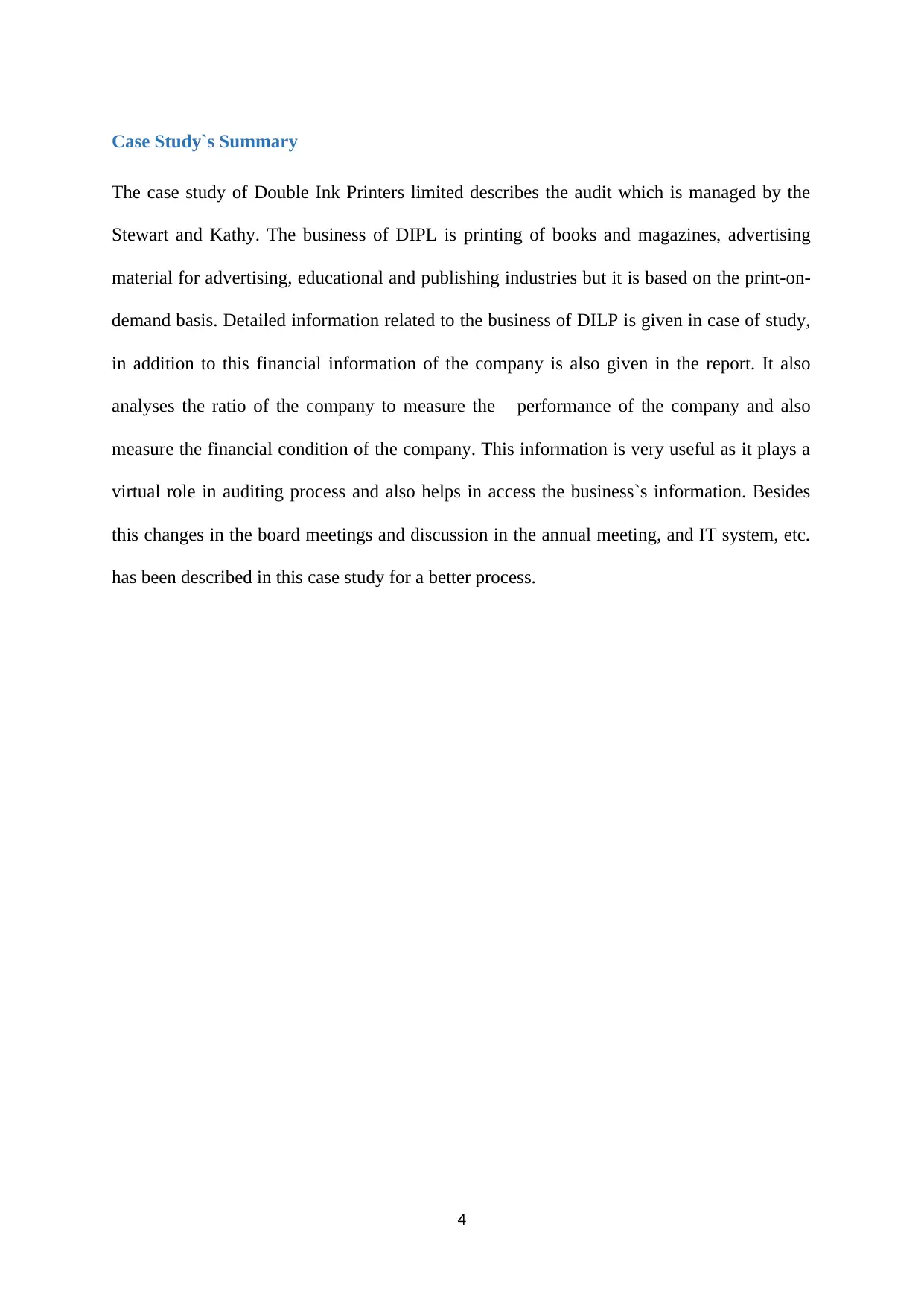
Case Study`s Summary
The case study of Double Ink Printers limited describes the audit which is managed by the
Stewart and Kathy. The business of DIPL is printing of books and magazines, advertising
material for advertising, educational and publishing industries but it is based on the print-on-
demand basis. Detailed information related to the business of DILP is given in case of study,
in addition to this financial information of the company is also given in the report. It also
analyses the ratio of the company to measure the performance of the company and also
measure the financial condition of the company. This information is very useful as it plays a
virtual role in auditing process and also helps in access the business`s information. Besides
this changes in the board meetings and discussion in the annual meeting, and IT system, etc.
has been described in this case study for a better process.
4
The case study of Double Ink Printers limited describes the audit which is managed by the
Stewart and Kathy. The business of DIPL is printing of books and magazines, advertising
material for advertising, educational and publishing industries but it is based on the print-on-
demand basis. Detailed information related to the business of DILP is given in case of study,
in addition to this financial information of the company is also given in the report. It also
analyses the ratio of the company to measure the performance of the company and also
measure the financial condition of the company. This information is very useful as it plays a
virtual role in auditing process and also helps in access the business`s information. Besides
this changes in the board meetings and discussion in the annual meeting, and IT system, etc.
has been described in this case study for a better process.
4
Secure Best Marks with AI Grader
Need help grading? Try our AI Grader for instant feedback on your assignments.
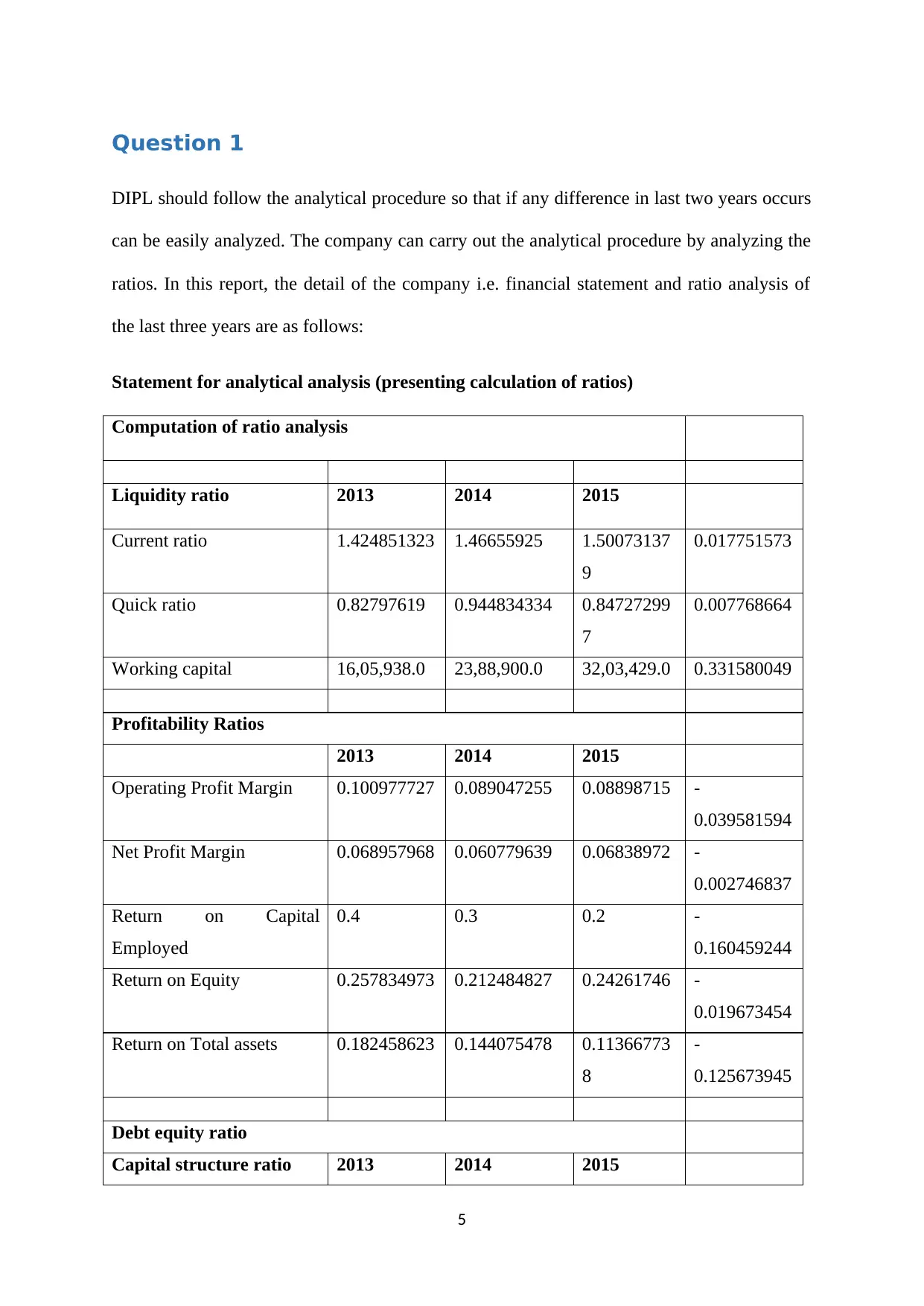
Question 1
DIPL should follow the analytical procedure so that if any difference in last two years occurs
can be easily analyzed. The company can carry out the analytical procedure by analyzing the
ratios. In this report, the detail of the company i.e. financial statement and ratio analysis of
the last three years are as follows:
Statement for analytical analysis (presenting calculation of ratios)
Computation of ratio analysis
Liquidity ratio 2013 2014 2015
Current ratio 1.424851323 1.46655925 1.50073137
9
0.017751573
Quick ratio 0.82797619 0.944834334 0.84727299
7
0.007768664
Working capital 16,05,938.0 23,88,900.0 32,03,429.0 0.331580049
Profitability Ratios
2013 2014 2015
Operating Profit Margin 0.100977727 0.089047255 0.08898715 -
0.039581594
Net Profit Margin 0.068957968 0.060779639 0.06838972 -
0.002746837
Return on Capital
Employed
0.4 0.3 0.2 -
0.160459244
Return on Equity 0.257834973 0.212484827 0.24261746 -
0.019673454
Return on Total assets 0.182458623 0.144075478 0.11366773
8
-
0.125673945
Debt equity ratio
Capital structure ratio 2013 2014 2015
5
DIPL should follow the analytical procedure so that if any difference in last two years occurs
can be easily analyzed. The company can carry out the analytical procedure by analyzing the
ratios. In this report, the detail of the company i.e. financial statement and ratio analysis of
the last three years are as follows:
Statement for analytical analysis (presenting calculation of ratios)
Computation of ratio analysis
Liquidity ratio 2013 2014 2015
Current ratio 1.424851323 1.46655925 1.50073137
9
0.017751573
Quick ratio 0.82797619 0.944834334 0.84727299
7
0.007768664
Working capital 16,05,938.0 23,88,900.0 32,03,429.0 0.331580049
Profitability Ratios
2013 2014 2015
Operating Profit Margin 0.100977727 0.089047255 0.08898715 -
0.039581594
Net Profit Margin 0.068957968 0.060779639 0.06838972 -
0.002746837
Return on Capital
Employed
0.4 0.3 0.2 -
0.160459244
Return on Equity 0.257834973 0.212484827 0.24261746 -
0.019673454
Return on Total assets 0.182458623 0.144075478 0.11366773
8
-
0.125673945
Debt equity ratio
Capital structure ratio 2013 2014 2015
5
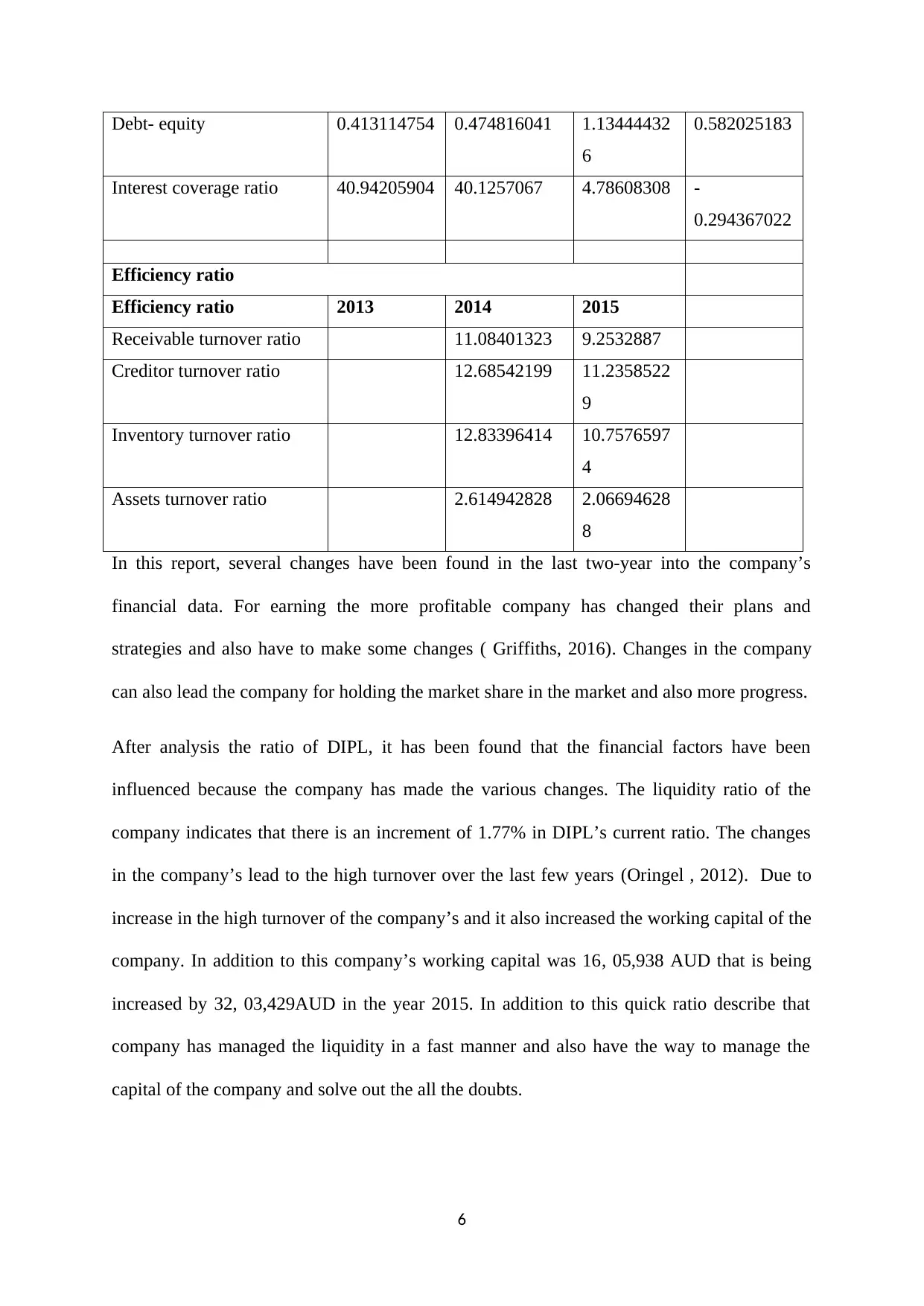
Debt- equity 0.413114754 0.474816041 1.13444432
6
0.582025183
Interest coverage ratio 40.94205904 40.1257067 4.78608308 -
0.294367022
Efficiency ratio
Efficiency ratio 2013 2014 2015
Receivable turnover ratio 11.08401323 9.2532887
Creditor turnover ratio 12.68542199 11.2358522
9
Inventory turnover ratio 12.83396414 10.7576597
4
Assets turnover ratio 2.614942828 2.06694628
8
In this report, several changes have been found in the last two-year into the company’s
financial data. For earning the more profitable company has changed their plans and
strategies and also have to make some changes ( Griffiths, 2016). Changes in the company
can also lead the company for holding the market share in the market and also more progress.
After analysis the ratio of DIPL, it has been found that the financial factors have been
influenced because the company has made the various changes. The liquidity ratio of the
company indicates that there is an increment of 1.77% in DIPL’s current ratio. The changes
in the company’s lead to the high turnover over the last few years (Oringel , 2012). Due to
increase in the high turnover of the company’s and it also increased the working capital of the
company. In addition to this company’s working capital was 16, 05,938 AUD that is being
increased by 32, 03,429AUD in the year 2015. In addition to this quick ratio describe that
company has managed the liquidity in a fast manner and also have the way to manage the
capital of the company and solve out the all the doubts.
6
6
0.582025183
Interest coverage ratio 40.94205904 40.1257067 4.78608308 -
0.294367022
Efficiency ratio
Efficiency ratio 2013 2014 2015
Receivable turnover ratio 11.08401323 9.2532887
Creditor turnover ratio 12.68542199 11.2358522
9
Inventory turnover ratio 12.83396414 10.7576597
4
Assets turnover ratio 2.614942828 2.06694628
8
In this report, several changes have been found in the last two-year into the company’s
financial data. For earning the more profitable company has changed their plans and
strategies and also have to make some changes ( Griffiths, 2016). Changes in the company
can also lead the company for holding the market share in the market and also more progress.
After analysis the ratio of DIPL, it has been found that the financial factors have been
influenced because the company has made the various changes. The liquidity ratio of the
company indicates that there is an increment of 1.77% in DIPL’s current ratio. The changes
in the company’s lead to the high turnover over the last few years (Oringel , 2012). Due to
increase in the high turnover of the company’s and it also increased the working capital of the
company. In addition to this company’s working capital was 16, 05,938 AUD that is being
increased by 32, 03,429AUD in the year 2015. In addition to this quick ratio describe that
company has managed the liquidity in a fast manner and also have the way to manage the
capital of the company and solve out the all the doubts.
6
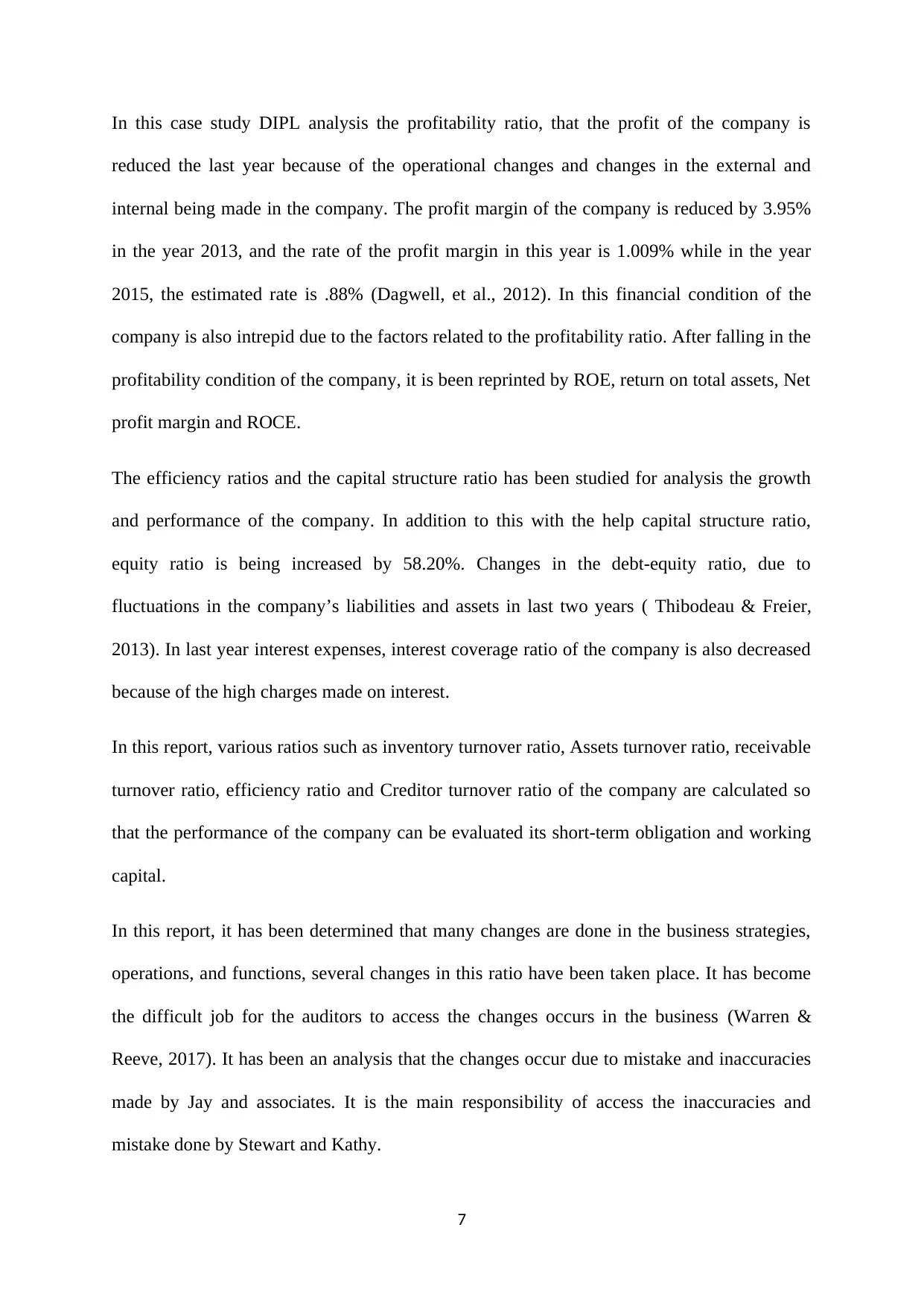
In this case study DIPL analysis the profitability ratio, that the profit of the company is
reduced the last year because of the operational changes and changes in the external and
internal being made in the company. The profit margin of the company is reduced by 3.95%
in the year 2013, and the rate of the profit margin in this year is 1.009% while in the year
2015, the estimated rate is .88% (Dagwell, et al., 2012). In this financial condition of the
company is also intrepid due to the factors related to the profitability ratio. After falling in the
profitability condition of the company, it is been reprinted by ROE, return on total assets, Net
profit margin and ROCE.
The efficiency ratios and the capital structure ratio has been studied for analysis the growth
and performance of the company. In addition to this with the help capital structure ratio,
equity ratio is being increased by 58.20%. Changes in the debt-equity ratio, due to
fluctuations in the company’s liabilities and assets in last two years ( Thibodeau & Freier,
2013). In last year interest expenses, interest coverage ratio of the company is also decreased
because of the high charges made on interest.
In this report, various ratios such as inventory turnover ratio, Assets turnover ratio, receivable
turnover ratio, efficiency ratio and Creditor turnover ratio of the company are calculated so
that the performance of the company can be evaluated its short-term obligation and working
capital.
In this report, it has been determined that many changes are done in the business strategies,
operations, and functions, several changes in this ratio have been taken place. It has become
the difficult job for the auditors to access the changes occurs in the business (Warren &
Reeve, 2017). It has been an analysis that the changes occur due to mistake and inaccuracies
made by Jay and associates. It is the main responsibility of access the inaccuracies and
mistake done by Stewart and Kathy.
7
reduced the last year because of the operational changes and changes in the external and
internal being made in the company. The profit margin of the company is reduced by 3.95%
in the year 2013, and the rate of the profit margin in this year is 1.009% while in the year
2015, the estimated rate is .88% (Dagwell, et al., 2012). In this financial condition of the
company is also intrepid due to the factors related to the profitability ratio. After falling in the
profitability condition of the company, it is been reprinted by ROE, return on total assets, Net
profit margin and ROCE.
The efficiency ratios and the capital structure ratio has been studied for analysis the growth
and performance of the company. In addition to this with the help capital structure ratio,
equity ratio is being increased by 58.20%. Changes in the debt-equity ratio, due to
fluctuations in the company’s liabilities and assets in last two years ( Thibodeau & Freier,
2013). In last year interest expenses, interest coverage ratio of the company is also decreased
because of the high charges made on interest.
In this report, various ratios such as inventory turnover ratio, Assets turnover ratio, receivable
turnover ratio, efficiency ratio and Creditor turnover ratio of the company are calculated so
that the performance of the company can be evaluated its short-term obligation and working
capital.
In this report, it has been determined that many changes are done in the business strategies,
operations, and functions, several changes in this ratio have been taken place. It has become
the difficult job for the auditors to access the changes occurs in the business (Warren &
Reeve, 2017). It has been an analysis that the changes occur due to mistake and inaccuracies
made by Jay and associates. It is the main responsibility of access the inaccuracies and
mistake done by Stewart and Kathy.
7
Paraphrase This Document
Need a fresh take? Get an instant paraphrase of this document with our AI Paraphraser

8
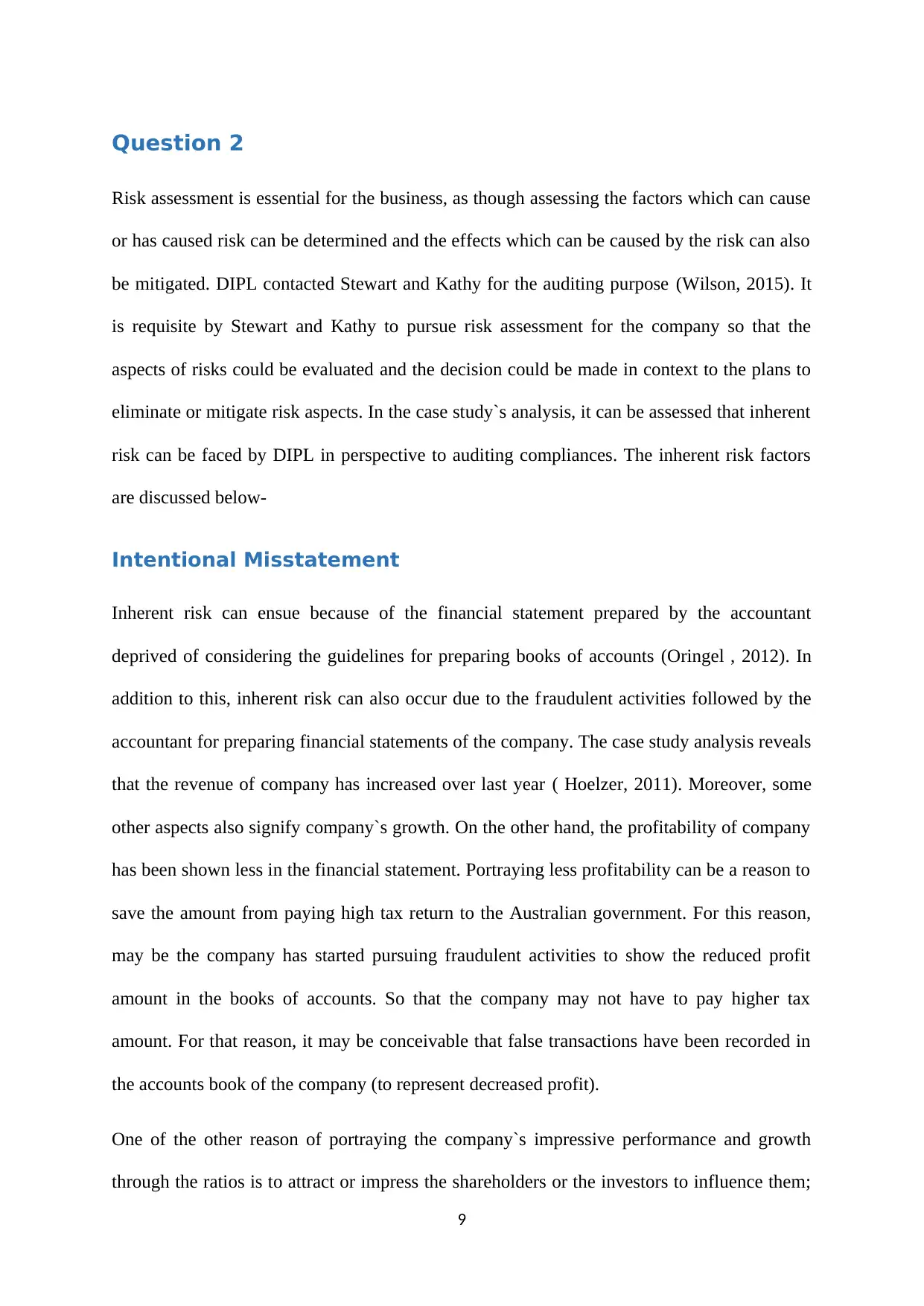
Question 2
Risk assessment is essential for the business, as though assessing the factors which can cause
or has caused risk can be determined and the effects which can be caused by the risk can also
be mitigated. DIPL contacted Stewart and Kathy for the auditing purpose (Wilson, 2015). It
is requisite by Stewart and Kathy to pursue risk assessment for the company so that the
aspects of risks could be evaluated and the decision could be made in context to the plans to
eliminate or mitigate risk aspects. In the case study`s analysis, it can be assessed that inherent
risk can be faced by DIPL in perspective to auditing compliances. The inherent risk factors
are discussed below-
Intentional Misstatement
Inherent risk can ensue because of the financial statement prepared by the accountant
deprived of considering the guidelines for preparing books of accounts (Oringel , 2012). In
addition to this, inherent risk can also occur due to the fraudulent activities followed by the
accountant for preparing financial statements of the company. The case study analysis reveals
that the revenue of company has increased over last year ( Hoelzer, 2011). Moreover, some
other aspects also signify company`s growth. On the other hand, the profitability of company
has been shown less in the financial statement. Portraying less profitability can be a reason to
save the amount from paying high tax return to the Australian government. For this reason,
may be the company has started pursuing fraudulent activities to show the reduced profit
amount in the books of accounts. So that the company may not have to pay higher tax
amount. For that reason, it may be conceivable that false transactions have been recorded in
the accounts book of the company (to represent decreased profit).
One of the other reason of portraying the company`s impressive performance and growth
through the ratios is to attract or impress the shareholders or the investors to influence them;
9
Risk assessment is essential for the business, as though assessing the factors which can cause
or has caused risk can be determined and the effects which can be caused by the risk can also
be mitigated. DIPL contacted Stewart and Kathy for the auditing purpose (Wilson, 2015). It
is requisite by Stewart and Kathy to pursue risk assessment for the company so that the
aspects of risks could be evaluated and the decision could be made in context to the plans to
eliminate or mitigate risk aspects. In the case study`s analysis, it can be assessed that inherent
risk can be faced by DIPL in perspective to auditing compliances. The inherent risk factors
are discussed below-
Intentional Misstatement
Inherent risk can ensue because of the financial statement prepared by the accountant
deprived of considering the guidelines for preparing books of accounts (Oringel , 2012). In
addition to this, inherent risk can also occur due to the fraudulent activities followed by the
accountant for preparing financial statements of the company. The case study analysis reveals
that the revenue of company has increased over last year ( Hoelzer, 2011). Moreover, some
other aspects also signify company`s growth. On the other hand, the profitability of company
has been shown less in the financial statement. Portraying less profitability can be a reason to
save the amount from paying high tax return to the Australian government. For this reason,
may be the company has started pursuing fraudulent activities to show the reduced profit
amount in the books of accounts. So that the company may not have to pay higher tax
amount. For that reason, it may be conceivable that false transactions have been recorded in
the accounts book of the company (to represent decreased profit).
One of the other reason of portraying the company`s impressive performance and growth
through the ratios is to attract or impress the shareholders or the investors to influence them;
9
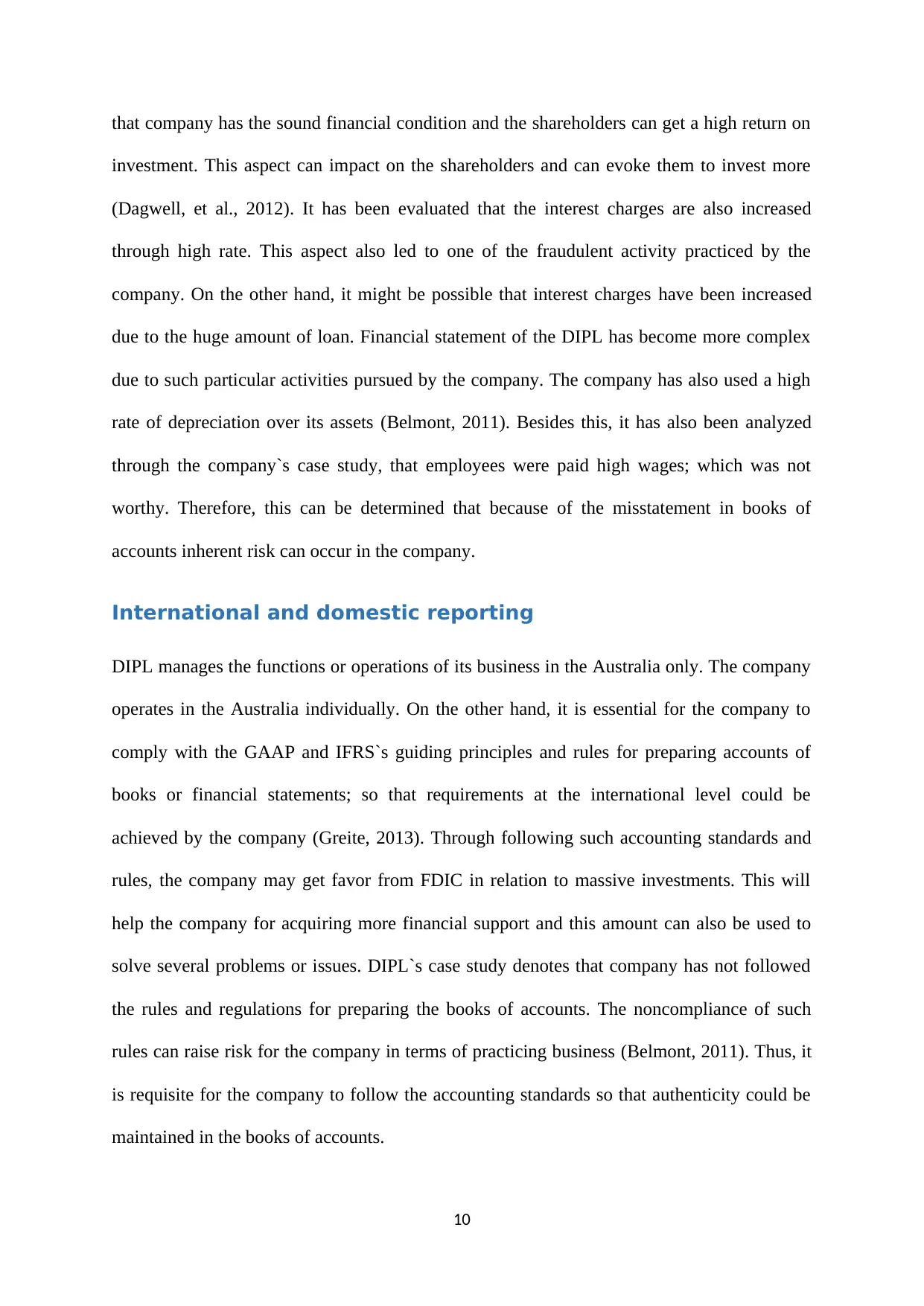
that company has the sound financial condition and the shareholders can get a high return on
investment. This aspect can impact on the shareholders and can evoke them to invest more
(Dagwell, et al., 2012). It has been evaluated that the interest charges are also increased
through high rate. This aspect also led to one of the fraudulent activity practiced by the
company. On the other hand, it might be possible that interest charges have been increased
due to the huge amount of loan. Financial statement of the DIPL has become more complex
due to such particular activities pursued by the company. The company has also used a high
rate of depreciation over its assets (Belmont, 2011). Besides this, it has also been analyzed
through the company`s case study, that employees were paid high wages; which was not
worthy. Therefore, this can be determined that because of the misstatement in books of
accounts inherent risk can occur in the company.
International and domestic reporting
DIPL manages the functions or operations of its business in the Australia only. The company
operates in the Australia individually. On the other hand, it is essential for the company to
comply with the GAAP and IFRS`s guiding principles and rules for preparing accounts of
books or financial statements; so that requirements at the international level could be
achieved by the company (Greite, 2013). Through following such accounting standards and
rules, the company may get favor from FDIC in relation to massive investments. This will
help the company for acquiring more financial support and this amount can also be used to
solve several problems or issues. DIPL`s case study denotes that company has not followed
the rules and regulations for preparing the books of accounts. The noncompliance of such
rules can raise risk for the company in terms of practicing business (Belmont, 2011). Thus, it
is requisite for the company to follow the accounting standards so that authenticity could be
maintained in the books of accounts.
10
investment. This aspect can impact on the shareholders and can evoke them to invest more
(Dagwell, et al., 2012). It has been evaluated that the interest charges are also increased
through high rate. This aspect also led to one of the fraudulent activity practiced by the
company. On the other hand, it might be possible that interest charges have been increased
due to the huge amount of loan. Financial statement of the DIPL has become more complex
due to such particular activities pursued by the company. The company has also used a high
rate of depreciation over its assets (Belmont, 2011). Besides this, it has also been analyzed
through the company`s case study, that employees were paid high wages; which was not
worthy. Therefore, this can be determined that because of the misstatement in books of
accounts inherent risk can occur in the company.
International and domestic reporting
DIPL manages the functions or operations of its business in the Australia only. The company
operates in the Australia individually. On the other hand, it is essential for the company to
comply with the GAAP and IFRS`s guiding principles and rules for preparing accounts of
books or financial statements; so that requirements at the international level could be
achieved by the company (Greite, 2013). Through following such accounting standards and
rules, the company may get favor from FDIC in relation to massive investments. This will
help the company for acquiring more financial support and this amount can also be used to
solve several problems or issues. DIPL`s case study denotes that company has not followed
the rules and regulations for preparing the books of accounts. The noncompliance of such
rules can raise risk for the company in terms of practicing business (Belmont, 2011). Thus, it
is requisite for the company to follow the accounting standards so that authenticity could be
maintained in the books of accounts.
10
Secure Best Marks with AI Grader
Need help grading? Try our AI Grader for instant feedback on your assignments.
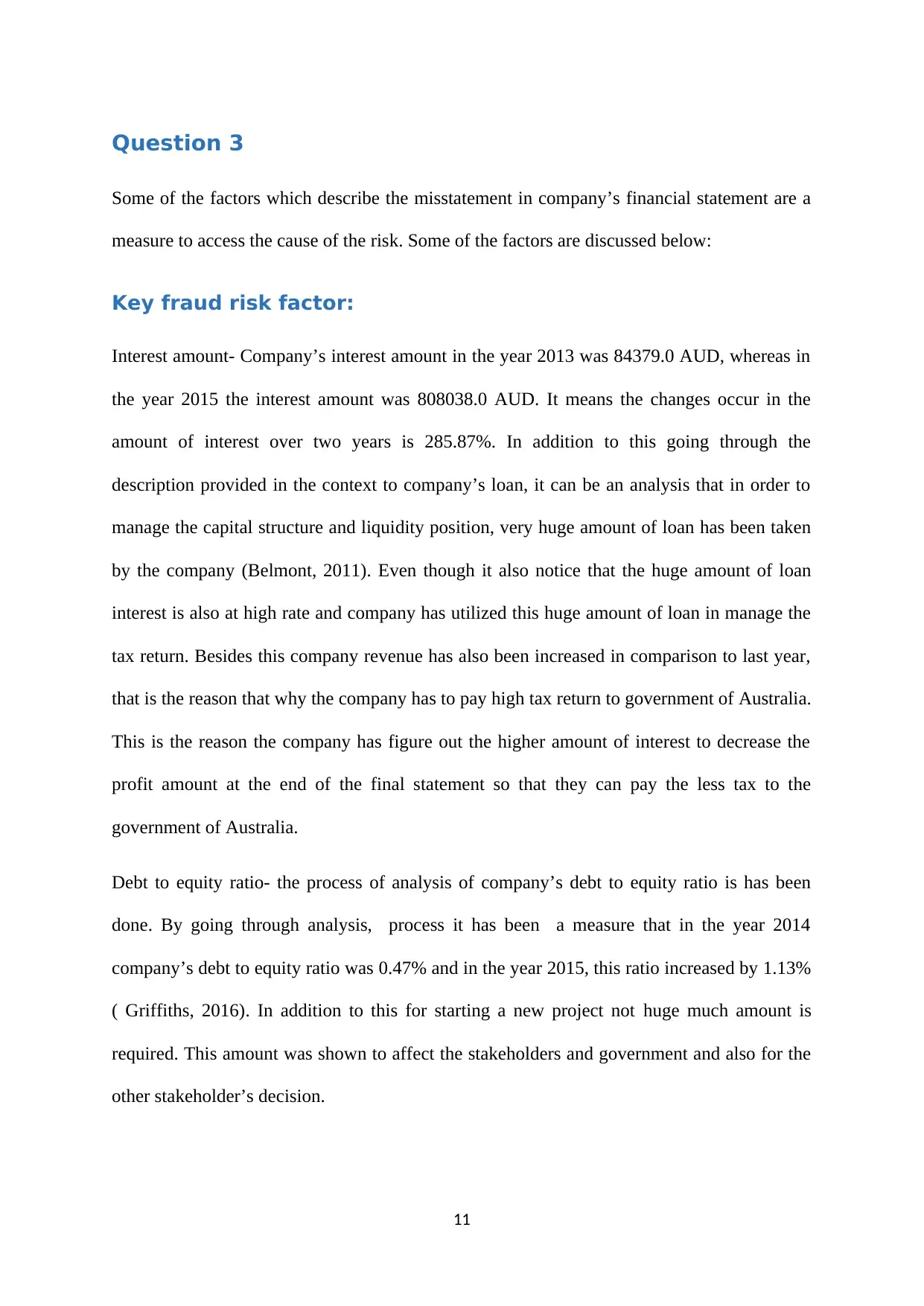
Question 3
Some of the factors which describe the misstatement in company’s financial statement are a
measure to access the cause of the risk. Some of the factors are discussed below:
Key fraud risk factor:
Interest amount- Company’s interest amount in the year 2013 was 84379.0 AUD, whereas in
the year 2015 the interest amount was 808038.0 AUD. It means the changes occur in the
amount of interest over two years is 285.87%. In addition to this going through the
description provided in the context to company’s loan, it can be an analysis that in order to
manage the capital structure and liquidity position, very huge amount of loan has been taken
by the company (Belmont, 2011). Even though it also notice that the huge amount of loan
interest is also at high rate and company has utilized this huge amount of loan in manage the
tax return. Besides this company revenue has also been increased in comparison to last year,
that is the reason that why the company has to pay high tax return to government of Australia.
This is the reason the company has figure out the higher amount of interest to decrease the
profit amount at the end of the final statement so that they can pay the less tax to the
government of Australia.
Debt to equity ratio- the process of analysis of company’s debt to equity ratio is has been
done. By going through analysis, process it has been a measure that in the year 2014
company’s debt to equity ratio was 0.47% and in the year 2015, this ratio increased by 1.13%
( Griffiths, 2016). In addition to this for starting a new project not huge much amount is
required. This amount was shown to affect the stakeholders and government and also for the
other stakeholder’s decision.
11
Some of the factors which describe the misstatement in company’s financial statement are a
measure to access the cause of the risk. Some of the factors are discussed below:
Key fraud risk factor:
Interest amount- Company’s interest amount in the year 2013 was 84379.0 AUD, whereas in
the year 2015 the interest amount was 808038.0 AUD. It means the changes occur in the
amount of interest over two years is 285.87%. In addition to this going through the
description provided in the context to company’s loan, it can be an analysis that in order to
manage the capital structure and liquidity position, very huge amount of loan has been taken
by the company (Belmont, 2011). Even though it also notice that the huge amount of loan
interest is also at high rate and company has utilized this huge amount of loan in manage the
tax return. Besides this company revenue has also been increased in comparison to last year,
that is the reason that why the company has to pay high tax return to government of Australia.
This is the reason the company has figure out the higher amount of interest to decrease the
profit amount at the end of the final statement so that they can pay the less tax to the
government of Australia.
Debt to equity ratio- the process of analysis of company’s debt to equity ratio is has been
done. By going through analysis, process it has been a measure that in the year 2014
company’s debt to equity ratio was 0.47% and in the year 2015, this ratio increased by 1.13%
( Griffiths, 2016). In addition to this for starting a new project not huge much amount is
required. This amount was shown to affect the stakeholders and government and also for the
other stakeholder’s decision.
11
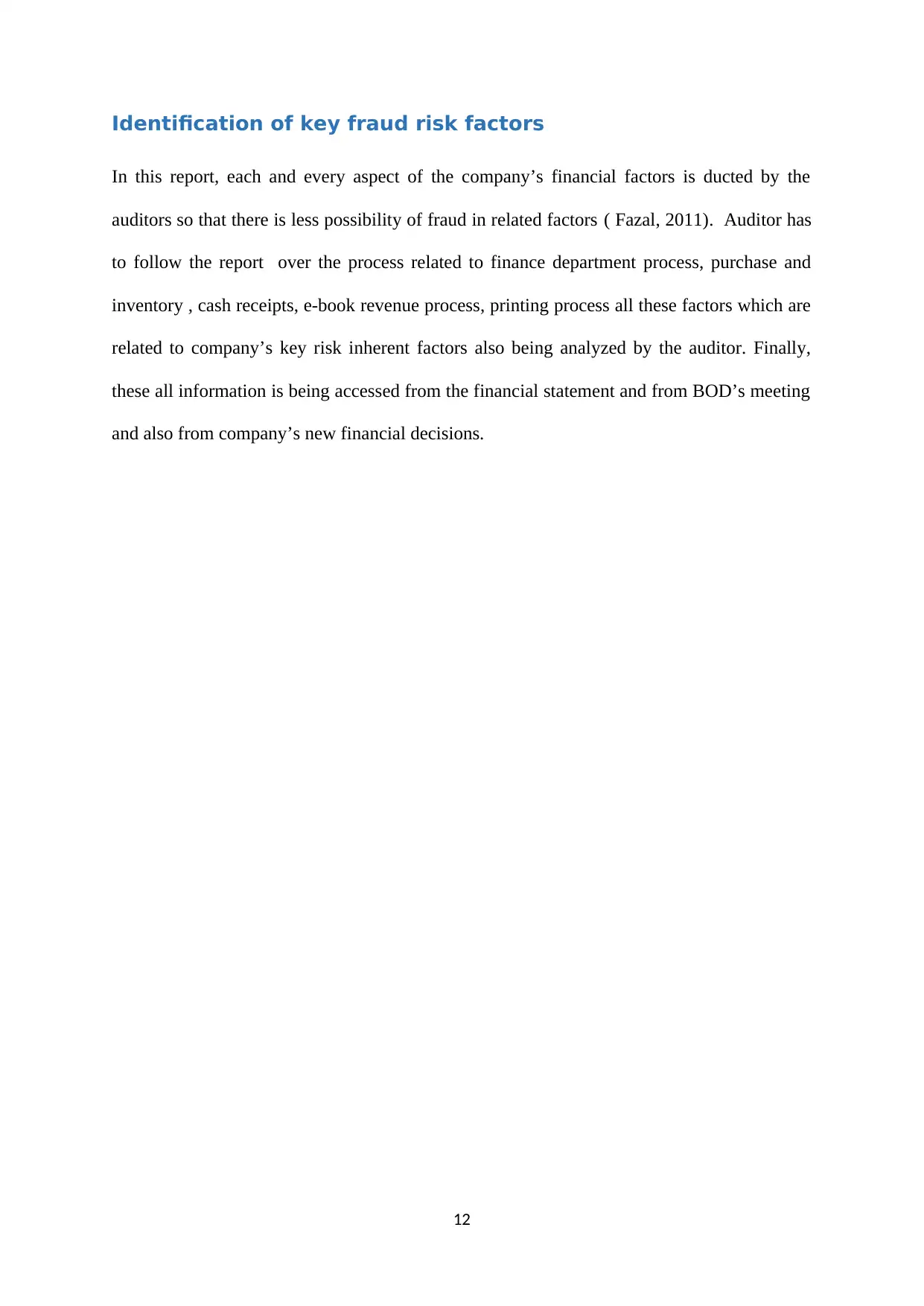
Identification of key fraud risk factors
In this report, each and every aspect of the company’s financial factors is ducted by the
auditors so that there is less possibility of fraud in related factors ( Fazal, 2011). Auditor has
to follow the report over the process related to finance department process, purchase and
inventory , cash receipts, e-book revenue process, printing process all these factors which are
related to company’s key risk inherent factors also being analyzed by the auditor. Finally,
these all information is being accessed from the financial statement and from BOD’s meeting
and also from company’s new financial decisions.
12
In this report, each and every aspect of the company’s financial factors is ducted by the
auditors so that there is less possibility of fraud in related factors ( Fazal, 2011). Auditor has
to follow the report over the process related to finance department process, purchase and
inventory , cash receipts, e-book revenue process, printing process all these factors which are
related to company’s key risk inherent factors also being analyzed by the auditor. Finally,
these all information is being accessed from the financial statement and from BOD’s meeting
and also from company’s new financial decisions.
12
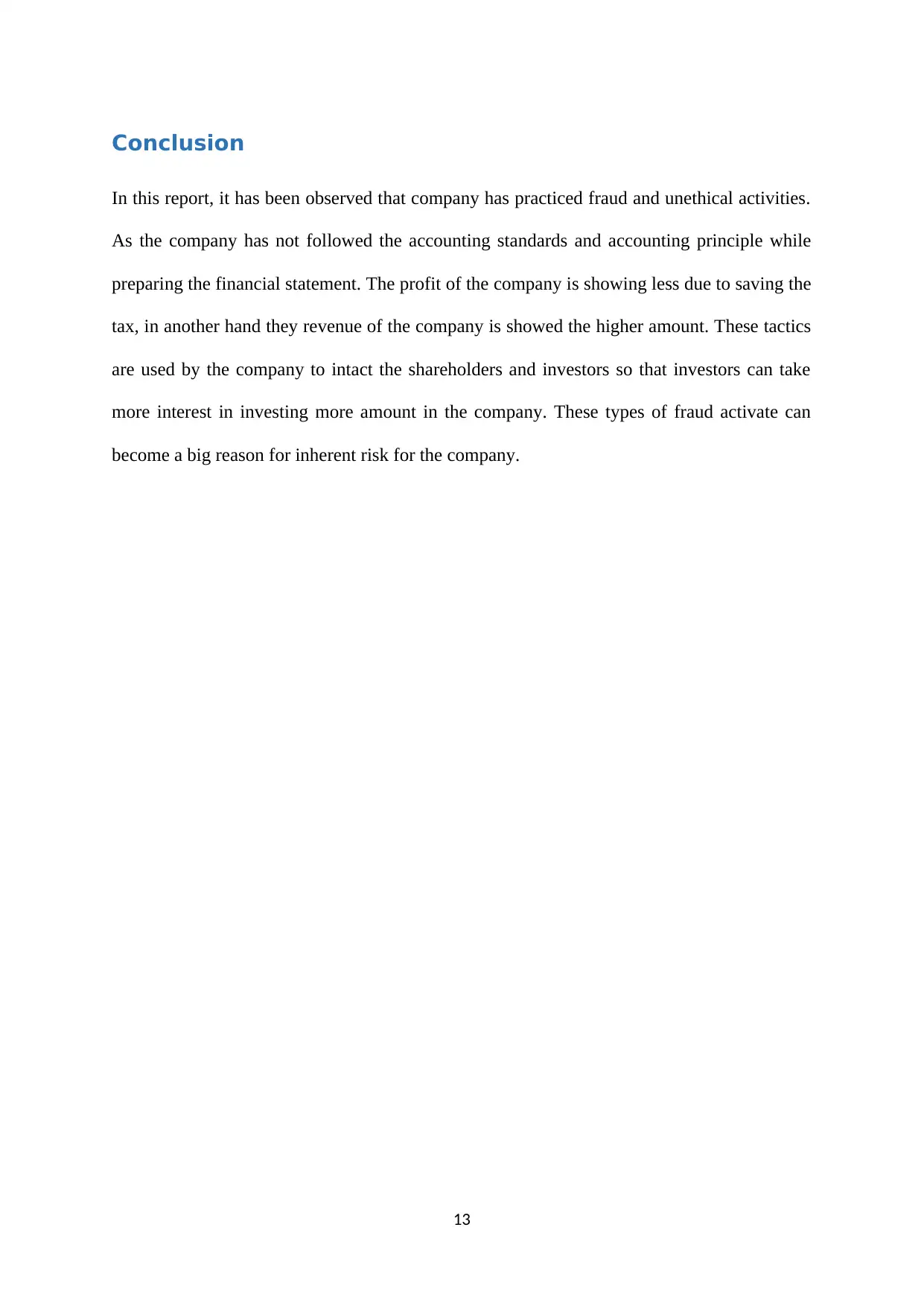
Conclusion
In this report, it has been observed that company has practiced fraud and unethical activities.
As the company has not followed the accounting standards and accounting principle while
preparing the financial statement. The profit of the company is showing less due to saving the
tax, in another hand they revenue of the company is showed the higher amount. These tactics
are used by the company to intact the shareholders and investors so that investors can take
more interest in investing more amount in the company. These types of fraud activate can
become a big reason for inherent risk for the company.
13
In this report, it has been observed that company has practiced fraud and unethical activities.
As the company has not followed the accounting standards and accounting principle while
preparing the financial statement. The profit of the company is showing less due to saving the
tax, in another hand they revenue of the company is showed the higher amount. These tactics
are used by the company to intact the shareholders and investors so that investors can take
more interest in investing more amount in the company. These types of fraud activate can
become a big reason for inherent risk for the company.
13
Paraphrase This Document
Need a fresh take? Get an instant paraphrase of this document with our AI Paraphraser
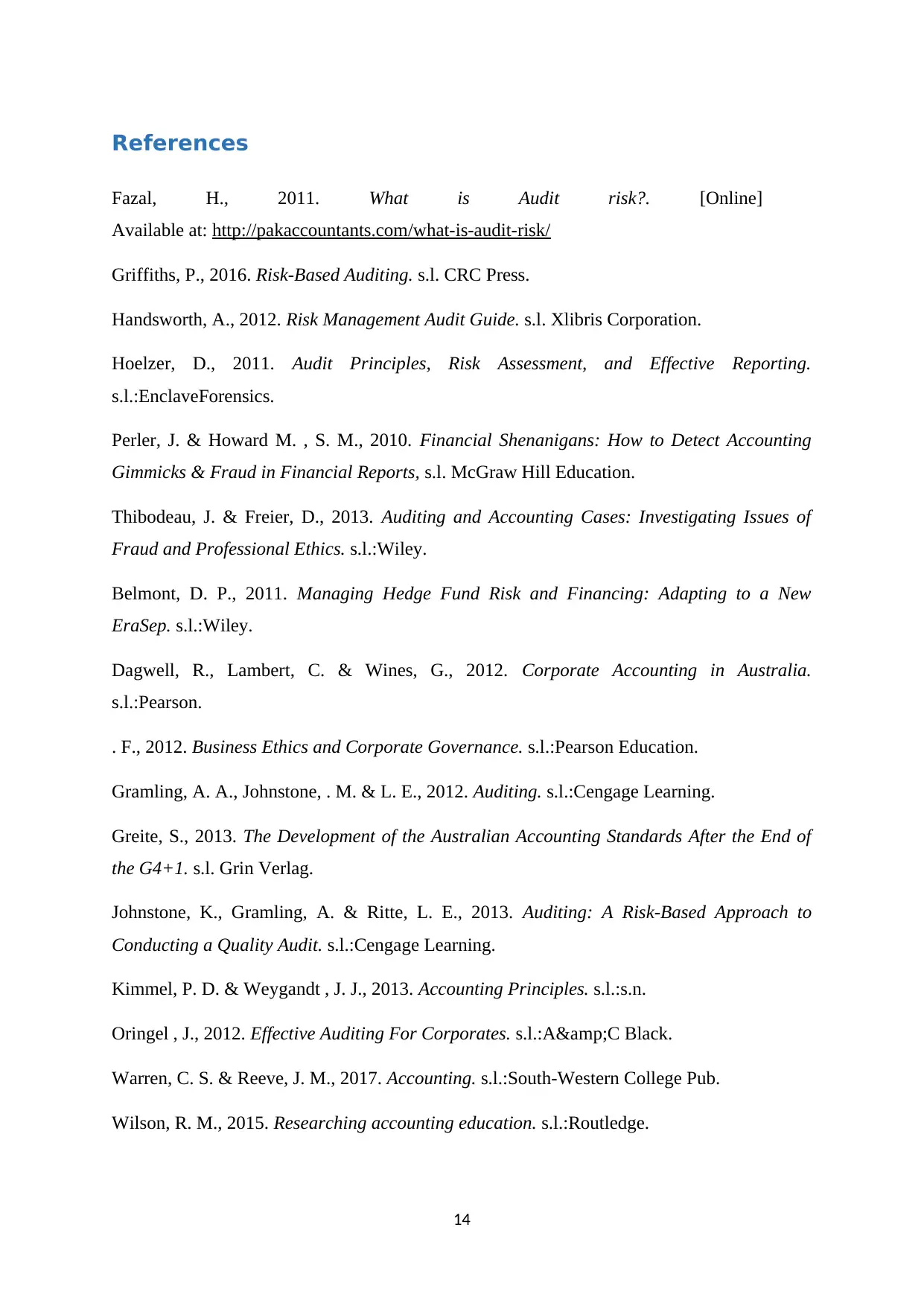
References
Fazal, H., 2011. What is Audit risk?. [Online]
Available at: http://pakaccountants.com/what-is-audit-risk/
Griffiths, P., 2016. Risk-Based Auditing. s.l. CRC Press.
Handsworth, A., 2012. Risk Management Audit Guide. s.l. Xlibris Corporation.
Hoelzer, D., 2011. Audit Principles, Risk Assessment, and Effective Reporting.
s.l.:EnclaveForensics.
Perler, J. & Howard M. , S. M., 2010. Financial Shenanigans: How to Detect Accounting
Gimmicks & Fraud in Financial Reports, s.l. McGraw Hill Education.
Thibodeau, J. & Freier, D., 2013. Auditing and Accounting Cases: Investigating Issues of
Fraud and Professional Ethics. s.l.:Wiley.
Belmont, D. P., 2011. Managing Hedge Fund Risk and Financing: Adapting to a New
EraSep. s.l.:Wiley.
Dagwell, R., Lambert, C. & Wines, G., 2012. Corporate Accounting in Australia.
s.l.:Pearson.
. F., 2012. Business Ethics and Corporate Governance. s.l.:Pearson Education.
Gramling, A. A., Johnstone, . M. & L. E., 2012. Auditing. s.l.:Cengage Learning.
Greite, S., 2013. The Development of the Australian Accounting Standards After the End of
the G4+1. s.l. Grin Verlag.
Johnstone, K., Gramling, A. & Ritte, L. E., 2013. Auditing: A Risk-Based Approach to
Conducting a Quality Audit. s.l.:Cengage Learning.
Kimmel, P. D. & Weygandt , J. J., 2013. Accounting Principles. s.l.:s.n.
Oringel , J., 2012. Effective Auditing For Corporates. s.l.:A&C Black.
Warren, C. S. & Reeve, J. M., 2017. Accounting. s.l.:South-Western College Pub.
Wilson, R. M., 2015. Researching accounting education. s.l.:Routledge.
14
Fazal, H., 2011. What is Audit risk?. [Online]
Available at: http://pakaccountants.com/what-is-audit-risk/
Griffiths, P., 2016. Risk-Based Auditing. s.l. CRC Press.
Handsworth, A., 2012. Risk Management Audit Guide. s.l. Xlibris Corporation.
Hoelzer, D., 2011. Audit Principles, Risk Assessment, and Effective Reporting.
s.l.:EnclaveForensics.
Perler, J. & Howard M. , S. M., 2010. Financial Shenanigans: How to Detect Accounting
Gimmicks & Fraud in Financial Reports, s.l. McGraw Hill Education.
Thibodeau, J. & Freier, D., 2013. Auditing and Accounting Cases: Investigating Issues of
Fraud and Professional Ethics. s.l.:Wiley.
Belmont, D. P., 2011. Managing Hedge Fund Risk and Financing: Adapting to a New
EraSep. s.l.:Wiley.
Dagwell, R., Lambert, C. & Wines, G., 2012. Corporate Accounting in Australia.
s.l.:Pearson.
. F., 2012. Business Ethics and Corporate Governance. s.l.:Pearson Education.
Gramling, A. A., Johnstone, . M. & L. E., 2012. Auditing. s.l.:Cengage Learning.
Greite, S., 2013. The Development of the Australian Accounting Standards After the End of
the G4+1. s.l. Grin Verlag.
Johnstone, K., Gramling, A. & Ritte, L. E., 2013. Auditing: A Risk-Based Approach to
Conducting a Quality Audit. s.l.:Cengage Learning.
Kimmel, P. D. & Weygandt , J. J., 2013. Accounting Principles. s.l.:s.n.
Oringel , J., 2012. Effective Auditing For Corporates. s.l.:A&C Black.
Warren, C. S. & Reeve, J. M., 2017. Accounting. s.l.:South-Western College Pub.
Wilson, R. M., 2015. Researching accounting education. s.l.:Routledge.
14

15
1 out of 15
Related Documents
Your All-in-One AI-Powered Toolkit for Academic Success.
+13062052269
info@desklib.com
Available 24*7 on WhatsApp / Email
![[object Object]](/_next/static/media/star-bottom.7253800d.svg)
Unlock your academic potential
© 2024 | Zucol Services PVT LTD | All rights reserved.





